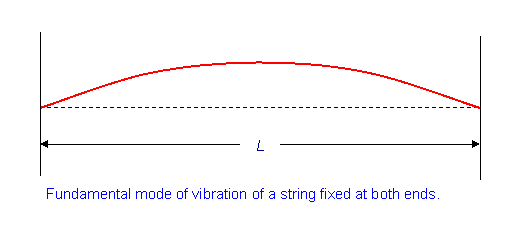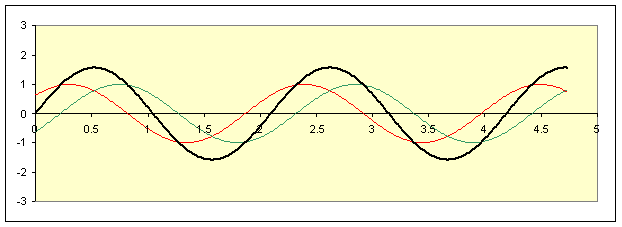7:53 PM Analyzing Waves on a String Michael Fowler 5/30/08 | |
Analyzing Waves on a StringMichael Fowler 5/30/08 From Newton’s Laws to the Wave EquationEverything there is to know about waves on a uniform string can be found by applying Newton’s Second Law,
Let’s write down
Taking the string to have mass density
The forces on the bit of string (neglecting the tiny force of gravity, air resistance, etc.) are the tensions T at the two ends. The tension will be uniform in magnitude along the string, but the string curves if it’s waving, so the two
Bearing in mind that we’re only interested here in small amplitude waves, we can see from the diagram (squashing it mentally in the y-direction) that both
The vertical component of the tension
However, if the wave amplitude is small, as we’re assuming, then
the equality becoming exact in the limit
At this point, it is necessary to make clear that y is a function of t as well as of x:
So we should write:
The final piece of the puzzle is the acceleration of the bit of string: in our small amplitude approximation, it’s only moving up and down, that is, in the y-direction—so the acceleration is just
This is called the wave equation. It’s worth looking at this equation to see why it is equivalent to Solving the Wave EquationNow that we’ve derived a wave equation from analyzing the motion of a tiny piece of string, we must check to see that it is consistent with our previous assertions about waves, which were based on experiment and observation. For example, we stated that a wave traveling down a rope kept its shape, so we could write
and the equation becomes
so the function
All traveling waves move at the same speed—and the speed is determined by the tension and the mass per unit length. We could have figured out the equation for v2dimensionally, but there would have been an overall arbitrary constant. We need the wave equation to prove that constant is 1.
Incorporating the above result, the equation is often written:
Of course, waves can travel both ways on a string: an arbitrary function The Principle of SuperpositionThe wave equation has a very important property: if we have two solutions to the equation, then the sum of the two is also a solution to the equation. It’s easy to check this:
Any differential equation for which this property holds is called a linear differential equation: note that Harmonic Traveling WavesImagine that one end of a long taut string is attached to a simple harmonic oscillator, such as a tuning fork—this will send a harmonic wave down the string,
The standard notation is
where of course
More notation: the wavelength of this traveling wave is
At a fixed x, the string goes up and down with frequency given by
Now imagine you’re standing at the origin watching the wave go by. You see the string at the origin do a complete up-and-down cycle f times per second. Each time it does this, a whole wavelength of the wave travels by. Suppose that at t = 0 the wave, coming in from the left, has just reached you.
Then at t = 1 second, the front of the wave will have traveled f wavelengths past you—so the speed at which the wave is traveling
Energy and Power in a Traveling Harmonic WaveIf we jiggle one end of a string and send a wave down its length, we are obviously supplying energy to the string—for one thing, as the wave moves down, bits of the string begin moving, so there is kinetic energy. And, there’s also potential energy—remember the wave won’t go down at all unless there is tension in the string, and when the string is waving it’s obviously longer than when it’s motionless along the x-axis. This stretching of the string takes work against the tension T equal to force times distance, in this case equal to the force T multiplied by the distance the string has been stretched. (We assume that this increase in length is not sufficient to cause significant increase in T. This is usually ok.)
For the important case of a harmonic wave traveling along a string, we can work out the energy per unit length exactly. We take
If the string has mass
For the harmonic wave
and since the average value
To find the average potential energy in a meter of string as the wave moves through, we need to know how much the string is stretched by the wave, and multiply that length increase by the tension T.
Let’s start with a small length
The string (red) is the hypotenuse of this right-angled triangle, so the amount of stretching
So
Remembering that we’re only considering small amplitude waves,
to find
To find the total stretching of a unit length of string, we add all these small stretches, taking the limit of small
Now, just as for the kinetic energy discussed above, since
That is to say, the average potential energy is the same as the average kinetic energy. This is a very general result: it is true for all harmonic oscillators (excepting the case of heavy damping).
Finally, the power in a wave traveling down a string is the rate at which it delivers energy at its destination. Adding together the kinetic and potential energy contributions above,
Now, if the wave is traveling at v meters per second, and being totally absorbed at its destination (the end of the string) the energy delivered to that end in one second is all the energy in the last v meters of the string. By definition, this is the power: the energy delivered in joules per second, That is,
Standing Waves from Traveling WavesAn amusing application of the principle of superposition is adding together harmonic traveling waves moving in opposite directions to get a standing wave:
You can easily check that
The longest wavelength standing wave for a string of length L fixed at both ends has wavelength
The x-dependence of this wave, sin kx, is clearly
The radial frequency of the wave is given by
(This is the same as the frequency
Here’s a realization of the superposition of two traveling waves to form a standing wave using a spreadsheet:
Here the red wave is
But this represents just one instant! To see the full development in time—which you need to do to get real insight into what’s going on—download the spreadsheet from http://galileo.phys.virginia.edu/classes/152.mf1i.spring02/WaveSum.xls ,then click and hold at the end of the slider bar to animate.
Exercise: How do you think the black wave will move if the red and green have different amplitudes? Predict it: then try it on the spreadsheet. You might be surprised! (Try different ratios of the wave amplitudes: say, 1.1, 1.5, 2, 5.) | |
|
| |
| Total comments: 0 | |







